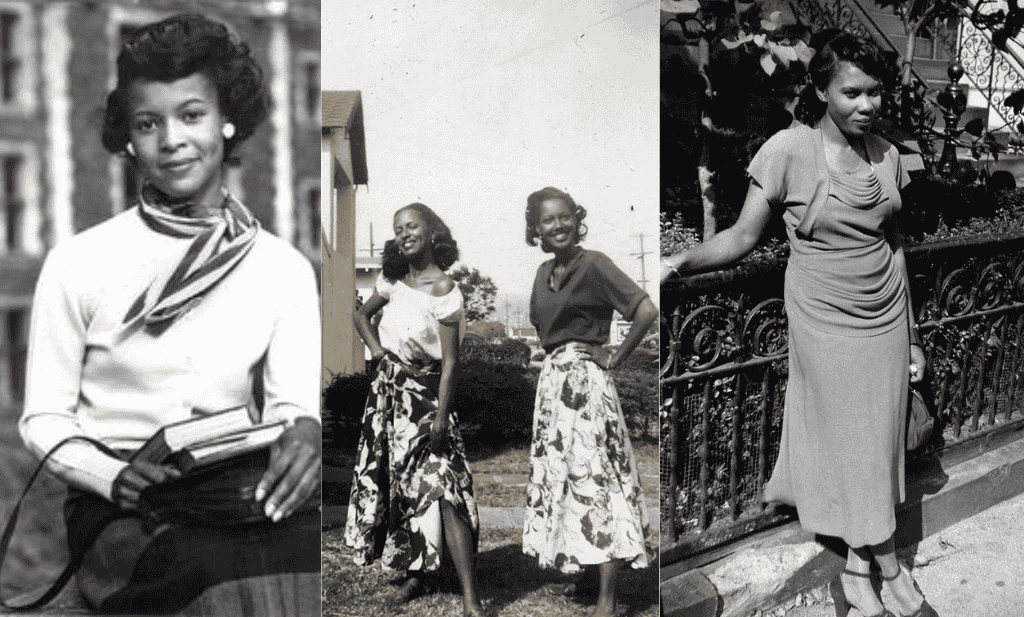The 1950s was a transformative decade for fashion, especially for Black women. Amid the rise of social movements, Black women’s fashion became a powerful expression of elegance, pride, and resilience. While mainstream fashion trends influenced many looks, Black women’s style carved a unique identity during this era. It balanced grace with an emerging spirit of empowerment, establishing a lasting legacy that still resonates today.
The Fashion Scene for Black Women in the 1950s
In the 1950s, social and economic circumstances shaped fashion choices for Black women. The era was marked by an increasing demand for equality, with Black women beginning to use fashion to assert their identity and dignity. Influences from Hollywood, music, and jazz culture also inspired notable figures like Dorothy Dandridge and Eartha Kitt, set trends, and inspired many.
Key Clothing Styles for 1950s Black Women
Hourglass Silhouettes
Fashion in the 1950s emphasized a feminine shape, with styles celebrating curves and creating an hourglass silhouette. Dresses and skirts were designed to accentuate the waist, creating an elegant and timeless look.
Dresses and Skirts as Daily Staples
wardrobe staple, often paired with stylish accessories to elevate even casual looks. Skirts were typically knee-length and, combined with tailored blouses, offered a chic, refined aesthetic that could be worn day to day.
Fabrics and Patterns of the Era
Commonly Used Fabrics
Cotton, silk, and wool were popular materials for comfort and versatility. These fabrics allowed for a polished look, especially in classic A-line skirts and fitted blouses.
Popular Patterns
Patterns like polka dots, stripes, and floral prints were widely embraced. These prints added vibrancy and personality to an outfit, making them a cherished part of Black women’s style.
Impact of the Civil Rights Movement on Black Women’s Fashion
The Civil Rights Movement profoundly influenced Black women’s fashion during the 1950s. Attire became a subtle yet impactful way to express pride and unity. Fashion choices reflected a commitment to self-respect and resilience, proving that clothing could symbolize personal and political identity.
Casual Wear Trends
Everyday Styles
Casual wear included capri pants, high-waisted jeans, and fitted blouses. These styles offered comfort and convenience without sacrificing elegance.
Hollywood Influence
The era’s Hollywood stars influenced Black women’s casual style, with looks inspired by movie stars and music icons who introduced a touch of glamour to everyday fashion.
Formal and Evening Wear
Evening Gowns and Cocktail Dresses
For formal occasions, Black women embraced elegant evening gowns and cocktail dresses. These were often embellished with sequins, lace, or satin, creating a sophisticated appearance for special events.
Influential Designers
While mainstream designers seldom catered to Black women, individuals still found ways to acquire or create stunning formalwear, often through local Black-owned tailors and dressmakers who understood their needs and preferences.
Hairstyles and Accessories
Popular Hairstyles
Hairstyles in the 1950s included relaxed waves, curls, and updos, which complemented casual and formal attire. Many Black women styled their hair with curlers, achieving soft, controlled waves.
Jewelry and Accessories
Accessories were essential, with pearls, gloves, and brooches adding finishing touches. These pieces reflected a woman’s style and elegance for church, community gatherings, or formal events.
Influential Black Women in 1950s Fashion
Icons like Dorothy Dandridge and Eartha Kitt significantly impacted Black fashion in the 1950s. Their roles in film and music brought attention to Black women’s style, inspiring others with their glamorous, sophisticated looks. These women set trends transcending racial boundaries, becoming symbols of beauty and elegance.
The Role of Churches and Community Events in Fashion
Church gatherings and community events were prominent occasions for Black women to showcase their finest attire. Church outfits often included beautifully tailored suits, hats, and gloves, reflecting reverence and a deep-rooted cultural appreciation for self-presentation.
The Influence of Music and Jazz Culture
Jazz was a major cultural force during the 1950s, influencing many aspects of Black life, including fashion. Dresses often featured bold, expressive patterns and accessories like large earrings and bangles. Jazz culture encouraged creativity, self-expression, and daring choices.
Challenges Black Women Faced in the Fashion Industry
Black women faced significant challenges in the fashion industry, such as limited representation in mainstream media and restricted access to popular brands. Despite these barriers, they found innovative ways to express their style, relying on creativity and the support of Black-owned businesses and designers.
How 1950s Black Women’s Fashion Influenced Later Decades
The fashion of 1950s Black women laid the foundation for many styles of the 1960s and 1970s. Elements of this era’s fashion—such as fitted silhouettes, patterned fabrics, and expressive accessories—continued to inspire future trends, especially within the Black community.
Vintage Revival of 1950s Black Women’s Fashion Today
Today, many are drawn to the vintage appeal of 1950s fashion. Modern designers reimagine these classic looks, incorporating bold prints, tailored dresses, and accessories reminiscent of the 1950s, honoring a period that balanced beauty with cultural pride.
Conclusion
The fashion of Black women in the 1950s is a testament to creativity, resilience, and self-expression. Black women navigated societal challenges through their style and carved out a distinct cultural identity. This era’s elegance, sophistication, and pride continue to inspire and captivate, bridging generations and leaving a timeless legacy in fashion.
FAQs
What were standard fabrics in 1950s Black women’s fashion?
Cotton, silk, and wool were commonly used, offering comfort and a polished look.
How did Black women style their hair in the 1950s?
Hairstyles included relaxed waves, curls, and updos, often achieved with curlers for controlled waves.
Who were the style icons for Black women in the 1950s?
Icons like Dorothy Dandridge and Eartha Kitt influenced Black fashion with glamorous and sophisticated looks.
What role did the Civil Rights Movement play in Black fashion?
The movement helped elevate fashion as a symbol of pride, resilience, and identity for Black women.
Are there elements of 1950s Black women’s fashion in today’s trends?
Yes, vintage 1950s styles, such as bold patterns and fitted silhouettes,
For more information, visit my blog:-zisbrand.com

